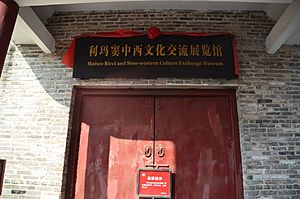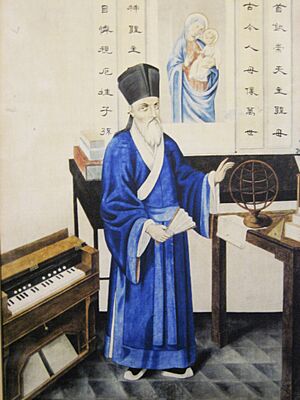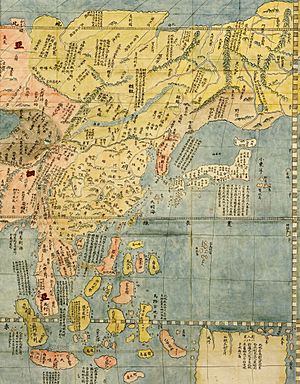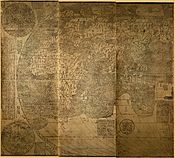Matteo Ricci facts for kids
Quick facts for kids Matteo Ricci S.J.利瑪竇 |
|
|---|---|
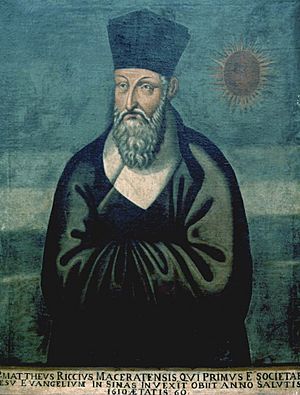
A 1610 Chinese portrait of Ricci
|
|
| Religion | Catholic |
| Order | Society of Jesus |
| Personal | |
| Born | 6 October 1552 Macerata, Papal States |
| Died | 11 May 1610 (aged 57) Beijing, Ming Empire |
| Resting place | Zhalan Cemetery, Beijing |
| Senior posting | |
| Title | Superior General of the China mission |
| Period in office | 1597–1610 |
| Successor | Nicolò Longobardo |
| Reason for exit | His death |
| Religious career | |
| Works | Kunyu Wanguo Quantu |
| Matteo Ricci | |||||||||
|---|---|---|---|---|---|---|---|---|---|
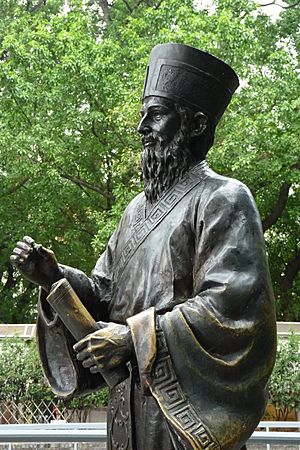
The statue of Ricci in downtown Macao, unveiled on 7 August 2010, the anniversary of his arrival on the island
|
|||||||||
| Traditional Chinese | 利瑪竇 | ||||||||
| Simplified Chinese | 利玛窦 | ||||||||
|
|||||||||
| Courtesy name: Xitai | |||||||||
| Chinese | 西泰 | ||||||||
|
|||||||||
| Servant of God Matteo Ricci |
|
|---|---|
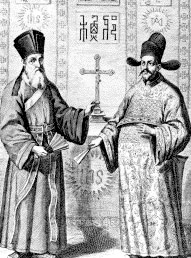
Matteo Ricci with Xu Guangqi (right)
|
|
| Priest, Missionary, Scholar | |
| Born | Macerata, Papal States |
| Died | Beijing, Ming Empire |
| Venerated in | Catholic Church |
| Attributes | Chinese Confucian scholar robes holding a crucifix and book |
Matteo Ricci (born October 6, 1552 – died May 11, 1610) was an Italian Jesuit priest. He was one of the first and most important figures in the Jesuit China missions. He created the Kunyu Wanguo Quantu, a world map from 1602 written in Chinese characters. The Catholic Church considers him a Servant of God.
Ricci arrived in the Portuguese settlement of Macau in 1582. There, he started his work as a missionary in China. In 1601, he became the first European to enter the Forbidden City in Beijing. He was invited by the Wanli Emperor, who wanted his help with things like court astronomy and the calendar. He helped several important Chinese officials become Catholics. He also worked with Chinese scholars, like Xu Guangqi, to translate Euclid's Elements into Chinese. They also translated Confucian classics into Latin for the first time.
Matteo Ricci's Early Life
Ricci was born on October 6, 1552, in Macerata. This city was part of the Papal States and is now in Italy. He studied classic subjects in his hometown. Then, he studied law in Rome for two years.
In April 1571, he joined the Society of Jesus at the Roman College. While there, he studied philosophy, theology, mathematics, and astronomy. His teacher was Christopher Clavius. In 1577, Ricci asked to join a missionary trip to the Far East. He sailed from Lisbon, Portugal, in March 1578. He arrived in Goa, a Portuguese colony, in September of that year. Ricci taught and worked in the ministry in Goa until 1582. Then, he was called to Macau to get ready to enter China. Ricci arrived in Macau in early August.
Matteo Ricci's Mission in China
In August 1582, Ricci arrived in Macau. This was a Portuguese trading post on the South China Sea. At that time, Christian missionary work in China was mostly limited to Macau. Some local Chinese people there had become Christians. Before Ricci, Michele Ruggieri was invited to Macau in 1579. He was asked to study Chinese to prepare for the Jesuits' mission into Mainland China.
Learning Chinese Culture
Once in Macau, Ricci studied the Chinese language and customs. This was the start of a long project. He became one of the first Western scholars to truly understand Chinese writing and Classical Chinese. With Ruggieri, he traveled to big cities in Guangdong. These included Canton and Zhaoqing. They wanted to set up a lasting Jesuit mission outside Macau.
In 1583, Ricci and Ruggieri settled in Zhaoqing. The governor of Zhaoqing, Wang Pan, invited them. He had heard about Ricci's skills in math and map-making. Ricci stayed in Zhaoqing from 1583 to 1589. He had to leave when a new viceroy took over.
Creating the First World Map in Chinese
It was in Zhaoqing, in 1584, that Ricci made the first European-style world map in Chinese. It was called "Da Ying Quan Tu." No copies of this 1584 map are known to exist today. However, a much better and bigger map, the Kunyu Wanguo Quantu from 1602, still exists in six copies.
During their time in Zhaoqing, Ricci and Ruggieri also made a Portuguese-Chinese dictionary. This was the first one in any European language. They created a system to write Chinese words using the Latin alphabet. This old manuscript was lost for a long time. It was found in 1934 and finally published in 2001.
Today, there is a special plaque in Zhaoqing to remember Ricci's six years there. There is also a "Ricci Memorial Centre" in a building from the 1860s.
Moving to Beijing
After being asked to leave Zhaoqing in 1588, Ricci got permission to move to Shaoguan. He set up his mission there again. Later, Ricci traveled to Nanjing and Nanchang in 1595. In August 1597, his superior, Alessandro Valignano, made him the main leader of the mission in China. Ricci held this important role until he died.
He moved to Tongzhou (a port near Beijing) in 1598. He first reached the capital city of Beijing on September 7, 1598. However, because of a war at the time, Ricci could not enter the Imperial Palace. After waiting for two months, he left Beijing. He went first to Nanjing and then to Suzhou.
In 1601, Ricci was invited to be an adviser to the Wanli Emperor's court. He was the first Westerner to be invited into the Forbidden City. This was because of Ricci's scientific skills. He was especially good at predicting solar eclipses, which were very important events in China. He also started the Cathedral of the Immaculate Conception in Beijing, the oldest Catholic church in the city.
Ricci could go into the Forbidden City freely. But he never actually met the emperor, who preferred to stay hidden. However, the emperor supported Ricci. He gave him money and helped Ricci finish the Zhifang Waiji, which was China's first world map.
Once he was settled in Beijing, Ricci met important officials and cultural leaders. He helped many of them become Christians. Ricci was also the first European to learn about the Kaifeng Jews. A member of that community visited Beijing in 1605 and contacted Ricci. Ricci never went to Kaifeng, but he sent a younger missionary there in 1608.
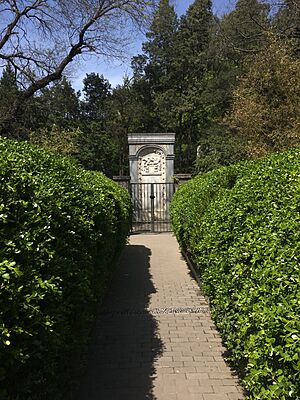
Ricci passed away on May 11, 1610, in Beijing, at 57 years old. By the rules of the Ming Dynasty, foreigners who died in China had to be buried in Macau. But Diego de Pantoja asked the court for a special burial spot in Beijing. He pointed out Ricci's important contributions to China. The Wanli Emperor agreed and gave a Buddhist temple for this purpose. In October 1610, Ricci's body was moved there. The graves of other missionaries like Ferdinand Verbiest and Johann Adam Schall von Bell are also there. This place became known as the Zhalan Cemetery. Today, it is inside the Beijing Administrative College.
Ricci was followed as the leader of the China mission by Nicolò Longobardo in 1610. Longobardo asked another Jesuit, Nicolas Trigault, to organize and translate Ricci's papers into Latin. This work was published in 1615 as De Christiana expeditione apud Sinas. It was soon translated into many other European languages.
Ricci's Respect for Chinese Culture
Ricci could speak Chinese well and also read and write classical Chinese. This was the formal language used by scholars and officials. He was known for how much he appreciated Chinese culture. He realized that Chinese culture was closely linked to Confucianism. So, he decided to use existing Chinese ideas to explain Christianity.
With his superior's approval, he connected with the educated Confucian scholars. He even dressed like them. He did not say that the Catholic faith was completely new or foreign. Instead, he said that Chinese culture and people had always believed in God. He explained that Christianity was simply the completion of their faith. He used a Chinese term, Tiānzhǔ (天主, "Lord of Heaven"), to describe the God of Abraham. This term came from traditional Chinese worship of Heaven. He also found many similar words in the Confucian Classics.
Ricci supported Chinese traditions, like respecting family ancestors. Some other missionaries, like the Dominicans and Franciscans, thought this was too much. They complained to the Vatican about it. This argument, called the Chinese rites controversy, went on for centuries. The Vatican made its most recent statement on it in 1939. Some people today praise Ricci for respectfully blending Christianity with local culture.
Ricci and Xu Guangqi were the first to translate some Confucian classics into a Western language, Latin. Ricci also met a Korean visitor to China. He taught him about Catholicism and gave him some books. These gifts, along with others from João Rodrigues in 1631, helped start Korea's Silhak movement.
Becoming a Saint
The process to make Matteo Ricci a saint began in 1984. It was reopened on January 24, 2010, in Italy. The local church finished its part of the process on May 10, 2013. Now, the case is with the Congregation for the Causes of Saints at the Vatican.
Remembering Matteo Ricci
Many places and groups are named after Matteo Ricci:
- Matteo Ricci Pacific Studies Reading Room at The National Central Library of Taiwan
- Ricci Hall, a dormitory at The University of Hong Kong
- Ricci Building at Wah Yan College, Kowloon in Hong Kong
- The Matteo Ricci Study Hall at the Ateneo de Manila University
- Matteo Ricci College, Kowloon in Hong Kong
- Matteo Ricci College at Seattle University
- Colégio Mateus Ricci, Macau
- Sekolah Katolik Ricci 1 and 2 in Jakarta, Indonesia
- Taipei Ricci Institute, Taiwan
- Macau Ricci Institute, Macau
- Ricci Institute for Chinese-Western Cultural History at the University of San Francisco
- The Matteo Ricci Seminar at Fordham University
- Centro Matteo Ricci, a center for refugees in Rome, Italy
- Matteo Ricci Hall and Ricci Hall Annex at Sogang University in Seoul, South Korea
To mark 400 years since Ricci's death, the Vatican Museums held a big exhibit about his life. An Italian film director, Gjon Kolndrekaj, also made a 60-minute documentary about Ricci in 2009. It was called Matteo Ricci: A Jesuit in the Dragon's Kingdom.
In Taipei, the Taipei Ricci Institute and the National Central Library of Taiwan opened the Matteo Ricci Pacific Studies Reading Room. Also, the online magazine eRenlai dedicated its June 2010 issue to Ricci.
Matteo Ricci's Important Works
The True Meaning of the Lord of Heaven
The True Meaning of the Lord of Heaven (天主實義) is a book written by Ricci. It says that Confucianism and Christianity are not against each other. In fact, they are very similar in important ways. It was written as a conversation, originally in Chinese. Ricci used this book to help convert Chinese scholars who were educated in Confucianism.

Other Key Works
- De Christiana expeditione apud Sinas: These were Ricci's journals. Another Jesuit, Nicolas Trigault, finished and translated them into Latin after Ricci died.
- Ricci's On Friendship, published in Chinese in 1595.
- Ricci's World Map of 1602.
- The Chinese translation of the ancient Greek mathematical book Euclid's Elements (幾何原本). This was published in 1607 by Matteo Ricci and his Chinese friend Xu Guangqi.
Images for kids
 In Spanish: Matteo Ricci para niños
In Spanish: Matteo Ricci para niños



